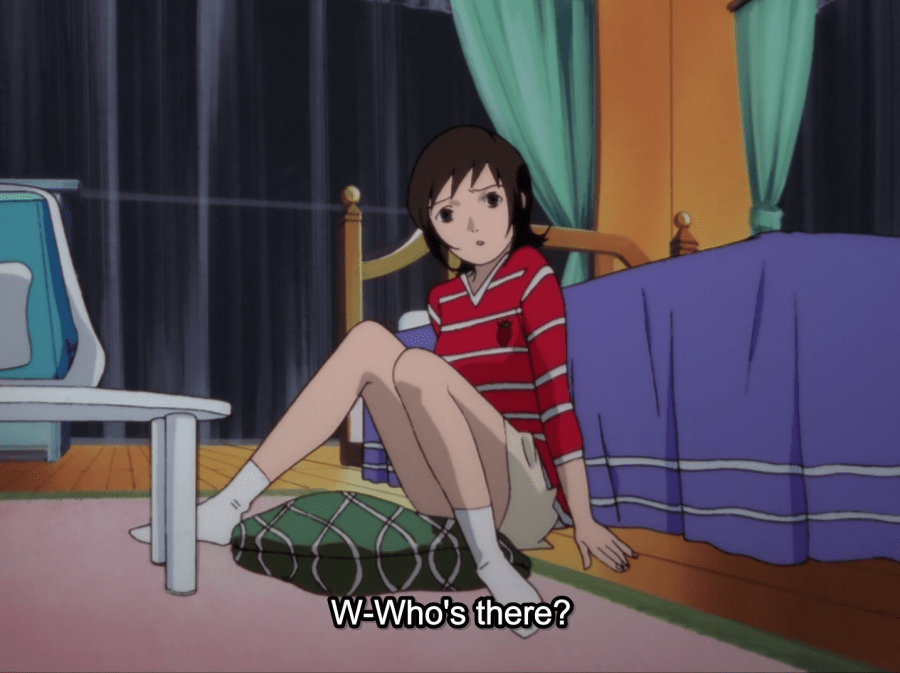As I mentioned last week, one can view Serial Experiments Lain as the story of a machine learning to become human, though unlike most series, Lain puts the audience in a position where we don’t know that the “machine” isn’t a human at first. Episode 11 goes a step further as Eiri explains to Lain that she isn’t a machine, actually—she’s software. And software, as we know, can have tremendous power and influence, and Lain uses such in an attempt to help one she loves.

Layer 11
Flashbacks rapidly pour back and forth, not in any sequential order and often relaying new material, namely the presence of Lain in certain key events. Eiri confronts Lain after this, discussing her nature as she slumps, exhausted, onto the floor. A form of Lain, with the body of the alien she has previously seen, approaches Alice to explain that she didn’t spread the rumor and would make sure the rumor disappear—Alice finds out the latter does come true the next day when she comes to school and realizes no one knows anything about her and the teacher with whom she wants (or has?) a relationship.
Navi…Loading…
Nothing about life is easy—most of all, our relationships.
The first half of layer eleven is spent in Lain’s mind as she uploads data into it, doing the work of breaking the boundary between the Wired and real life existence. Every major character in the series appears in flashbacks during this extended scene, expressing all the bonds she’s formed, whether significant or arbitrary, whether through her Wired self or the physical, whether pleasant or troubling.
In doing so, Lain continues her quest to remain grounded in reality, to prove that she really is and that physical existence is important. But all her relationships have been so flimsy, so meaningless except to connect her to the purpose Eiri has for her, that it’s a losing battle—at least until she thinks of Alice. More time is spent on Alice in the flashback than on any other bond, and rightly so—sheis the character who has loved Lain most.
I’ve read that Alice functions as a mother figure for Lain. I had previously considered her more of an older sister (and in Asian culture, as in others as well, the two are almost one in the same), but the mother relationship makes sense. Even in this flashback, physical affection that would occur between a mother and daughter is shown, and advice is given, sometimes hard advice, that one would hope to get from mom. Alice is shown grieving, too, for Lain’s “loss of innocence” after the shooting episode—very much a parental reaction.
Lain wants to do all she can to help Alice, and so, she erases data that relates to the rumors that spread. But Alice knows it’s been erased, and that’s part of what’s troubling. Alice has proven herself to be a young lady of character—although she has her shortcomings, as do we all, she has integrity, and so the change made by Lain doesn’t jive with her. It doesn’t feel right. There’s something wrong, beyond just that alien/Lain interface that appears and frightens her. This isn’t what should be happening, nor is it, perhaps, Alice’s wish to have whatever bond it is between her and the teacher broken.

Lain cannot everything right in the world by simply erasing a painful experience—the web of relationships is more complex than that and can’t be so easily unraveled. Chise, too, realizes as much—so confident in episode one that her body was no longer needed, she now sullenly looks at Lain on the Wired and nods “no,” emphasizing that it’s not easy to die. It’s not easy to leave your body behind, and thus all the interactions you have outside the digital realm.
Nothing is easy when it comes to relationships. That’s what makes them tricky to navigate, as Lain will discover, but it’s also why they are essential to existence, to life. In all their complexities and incivility and love, relationships are the very key to what it means to be human.
Present Day. Question Time.
- There are a number of critical scenes in the long flashback sequence. One is that Tachibana Labs is credited with mapping the human genome. Anyone want to make a connection and explain why that’s important? My brain is too fried after watching the episode to make that connection myself.
- By the way, just as with possible criticisms of “lazy animation,” only Serial Experiments Lain can get away with half a recap episode and package it as new, engaging material.
- It all comes back to Alice…lesser shows would have forgotten about her. Lain makes her a centerpiece.
- I can’t tell whether Eiri is doing a good job convincing Lain to come to him or a bad one.
- Creepy lain Lain finally appears!


Let us know your thoughts below! And join us next Friday for the next installment—only two episodes remain! Lain can be streamed on Crunchyroll.

I’m refraining for comment because I do remember the last episodes clearly and I don’t want to spoil them. But I remember this one being the high point of the nightmare. For me, nothing can be so confusing and alienating as being able to manipulate the world and its people as if it was software. It makes you live in a worls without consistence. The evil Lain helps, too.
About Tachibana labs (a Nichijou surname!), I think this mapping is related to the process of “uploading” people to the Wired (the person as a code), and also with those experiments with children of which Lain represents the pinnacle.
Uploading people to the Wired…mmm, that’s interesting. Thanks for the feedback, as usual!
[…] vs cults and humanity and Humanity and power/friendship and evolution and metaphysical truth to alienation through a maze-like narrative based on the mechanisms of the Internet. This is the cyberpunk […]